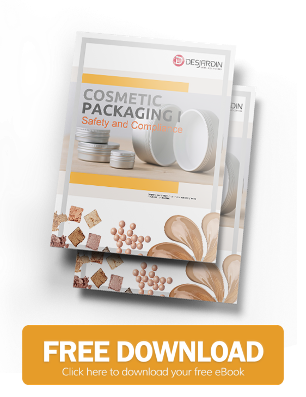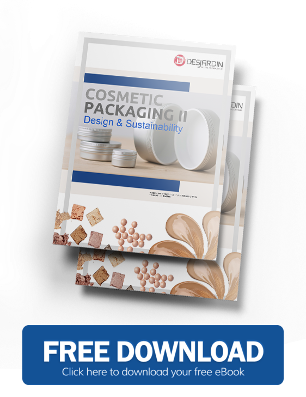What is the universal perfect package? This is a question that really has no answer. Packaging is best designed specifically to meet the needs of each product. In the cosmetic field there is a huge range of products, so the best form of packaging varies greatly on the product’s intended purpose, ingredients, and targeted audience.
Packaging is made up of two parts: the specification and the body. These are also known as design and non-design components. The specification encompass all aspects of aesthetics, like the shape, color, and label design of the package. The body deals with the structural integrity of the package with things like the materials and types of seals used [1]. Both of these components are equally important because they help sell and protect the product for consumers. In a market worth over $550 billion there is a large variety of products available and packaging is one of the first things that differentiates products from each other [2].
 The first important requirement to be considered for cosmetic packaging is its ability to attract consumers. Most consumers decide on what they will buy when they are already at the store and browsing the shelves. In this situation the visual elements of packaging need to help it stand out from the competition and catch the consumer’s eye. This can be done in a variety of ways, like having a unique shape, using eye catching colors, or a memorable logo. Unique packaging design is becoming more popular. For example, French brand Paul & Joe has a lipstick that is shaped like a cat face. A lot of time should be spent deciding on the design aspects of packaging as they have a large influence on consumers [3,5].
The first important requirement to be considered for cosmetic packaging is its ability to attract consumers. Most consumers decide on what they will buy when they are already at the store and browsing the shelves. In this situation the visual elements of packaging need to help it stand out from the competition and catch the consumer’s eye. This can be done in a variety of ways, like having a unique shape, using eye catching colors, or a memorable logo. Unique packaging design is becoming more popular. For example, French brand Paul & Joe has a lipstick that is shaped like a cat face. A lot of time should be spent deciding on the design aspects of packaging as they have a large influence on consumers [3,5].
The second area to be considered is making it structurally stable. This is mostly done by deciding on the correct outer material, seal, and interior coatings to use. These decisions are based on the ingredients of the product, how it will be transported, and possible contamination it can come into contact with. Cosmetics are known to have a large quantity of ingredients and some can be corrosive [4,6]. It is crucial that possible interactions between the ingredients and packaging material are thoroughly reviewed.
 The final area that should be considered for cosmetic packaging is if any extras should be included. These extras fall into a wide variety of categories and encompass everything that is not included in the previously mentioned areas. A few examples of these include moisture absorbers, technology links (like QR codes), and Coupons. They often provide additional benefits to the package, but are not integral for it to meet the minimum government requirements. Moisture absorbers are a great layer of protection for packaging that have moist contents, are very water sensitive, or will be transported in risky conditions. Technology links are becoming more popular and help provide additional information for consumers that there is not enough room on the package for [9]. This can be for videos or sponsor links online. Coupons are a classic way to increase consumer purchasing. They are easy to add and can be an effective way to leverage a product.
The final area that should be considered for cosmetic packaging is if any extras should be included. These extras fall into a wide variety of categories and encompass everything that is not included in the previously mentioned areas. A few examples of these include moisture absorbers, technology links (like QR codes), and Coupons. They often provide additional benefits to the package, but are not integral for it to meet the minimum government requirements. Moisture absorbers are a great layer of protection for packaging that have moist contents, are very water sensitive, or will be transported in risky conditions. Technology links are becoming more popular and help provide additional information for consumers that there is not enough room on the package for [9]. This can be for videos or sponsor links online. Coupons are a classic way to increase consumer purchasing. They are easy to add and can be an effective way to leverage a product.
Overall, creating the perfect cosmetic package requires a lot of research, thought, and time. It is an in depth process with many interconnected aspects that must be considered. Ultimately, the ‘ideal’ package is different for each product and should be designed on a case by case basis. That being said the ideal packaging for any cosmetic product should consider each of the aspects discussed for design and non-design components.
References
[1] "Package components (PL/SQL)") (retrieved May 2019), by IBM Knowledge Center.
[2] “Cosmetics Market by Category (Skin & Sun Care Products, Hair Care Products, Deodorants, Makeup & Color Cosmetics, Fragrances) and by Distribution Channel (General Departmental Store, Supermarkets, Drug Stores, Brand Outlets) - Global Opportunity Analysis and Industry Forecast” (2016), by Allied Market Research.
[3] "The 10 Most Creatively Packaged Cosmetics" (2012), by Danielle Pistono.
[4] "How to design cosmetics packaging: the ultimate guide " (2018), by Deanna deBara.
[5] “The importance of packaging attributes: a conjoint analysis approach" (2018), by Pinya Silayoi and Mark Speece.
[6] "Cosmetics and Perfumes. In: Glossary for the Worldwide Transportation of Dangerous Goods and Hazardous Materials" (1999), Malcolm A. Fox.
[7] "What you should know when packaging cosmetics compliant to FDA regulations" (2016), by Alex Cosper.
[8] "Understanding cosmetics-regulation" (retrieved April 2019), by Cosmetics Europe.
[9] “Cosmetic Products: Learning to Read Labels” (2012 ), by European Journal of Dermatology.






